The Butterfly Hunt: 2010
The air now carries the remains of summer’s warmth and the early coolness of fall. It is pleasant, but the place I live in is devoid of natural woods and shrubs. Whatever grows are horticulture plants or weeds on wastelands providing ecological services to the scarce but valuable biodiversity predominated by bumble bees, bottle flies and cabbage whites. Soon the landscape will transform into myriad of colors, from violet to red, but this time it’s the leaves. Thence the diversity will drop, hitting the lowest in January as winter grips onto southwestern Ontario. By March, green shoots will sprout from bare branches. Sign of life. As days roll by, the very first butterfly will make its appearance in the open, basking in the early spring sun. It will be a tattered Mourning Cloak – one of the butterflies that overwinter for months only to greet the season of spring – and will continue its lifecycle by laying eggs for summer.
| A Pearl Crescent decides to sip minerals off my finger |
It has been six months since I saw the first Mourning Cloak in the month of March this year, marking the beginning of my quest to photograph as many species of North American butterflies – specifically of southern Ontario – as possible. I managed to observe 31 species of butterflies at Long Point, Turkey Point, Port Rowan and Manitoulin Island. I missed many species, which I will never get to see this year. This is what is so exciting about the biodiversity in summer. You get one chance. And you either see the butterfly disappear high in the canopy, or are fortunate to study it more closely.
| A friendly Silvery Blue |
There are about 750 species of butterflies recorded in Canada. To date, only one subspecies of the Large Marble, found only on southern Vancouver Island is believed to be extinct. It’s interesting to note that there were very few people in the past who studied butterflies carefully – and these were dedicated naturalists and lepidopterists. Fortunately, in the recent years, there is more awareness about the diversity of these delicate insects, with more and more researchers as well as amateur naturalists set to explore the subtle differences in their lifecycles, the response to climate change, distribution as well as species diversity. The Government of Canada has a web-page dedicated to Butterfly Conservation, and they ask an intriguing question – Why would anyone care if a butterfly species or even subspecies disappeared? It is because butterflies are as important to the ecosystem as bees. They are also the indicators of the health of a habitat, which is based not only on the presence of flowering plants for the adults to sip from, but on the presence of the host-plants for caterpillars to munch on. In Ontario, two species – Frosted Elfin and Karner Blue have been placed on the Ontario Endangered Species list, but they are probably already extirpated in the province.
| Carolinian forests, as seen in Norfolk County where this photograph was taken, is an ideal habitat with rich undergrowth as well as dense canopy for butterflies |
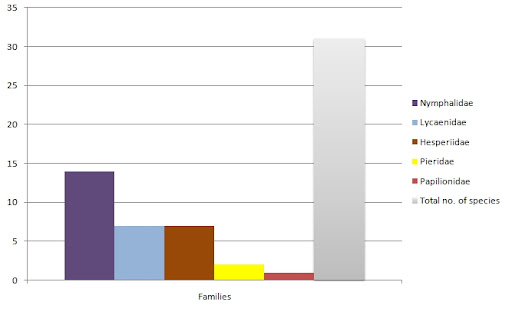 |
| Graph showing number of species observed from five families |
As it is clear from the graph, the diversity observed was higher for Nymphalidae (the largest family of butterflies), followed by Lycaenidae (second largest family), then by Hesperiidae, Pieridae and lastly Papilionidae. This trend is generally observed in the number of species occurring worldwide as well – with Nymphalidae having most number of species and Papilionidae having the least. The trend seen in the above graph could also probably be because of time and the place these butterflies were observed in. This is explained in the graph shown below.
I wish I also conducted a population count for these butterflies to see how the overall density rises and fall with the season, and to see if it rises or drops for ever species, depending on their time of emergence as well as on environmental factors. Let’s have a look at these butterflies one by one. Starting with the largest family Nymphalidae, I will descend to Papilionidae. All these families have distinct characteristics which are easy to observe on-field. I will recommend visiting Government of Canada’s CBIF website for more information on every species.
Nymphalidae: Marked by the presence of only four legs, this is because the first pair of legs is reduced to “brush” like structures – hence the butterflies of this family are commonly called Brush-footed butterflies.
1. Monarch, Danaus plexippus
| An adult Monarch sips nectar from Goldenrod at Manitoulin Island |
| Monarch caterpillar feeding on Butterfly Milkweed, Asclepias tuberosa at Turkey Point |
| A Monarch Caterpillar feeding on Common Milkweed, Asclepias syriaca at Manitoulin Island |
Viceroy is also famous for its mimicry of the Monarch. This mimicry is called Mullerian mimicry, where two or more harmful species share similar display patterns to deter predators. Like Monarchs however, Viceroy does not migrate. They are known to overwinter in larval stage.
3. Red Admiral, Vanessa atalanta
Red Admiral is a common butterfly of urban as well as woodlands. It is one of the last butterflies to be seen during fall.
4. White Admiral, Limenitis arthemis arthemis
There are two subspecies of White Admiral, L a. arthemis, as seen here and L a astyanax. While both subspecies are seen in Ontario, I found L a. arthemis to be more common at Manitoulin Island than at Long Point.
5. Common Buckeye, Junonia coenia
According to CBIF, the migrating butterflies show up first in Southern Ontario in June and if colonies are established by egg-carrying females, they can last through several generations to early September. This explains why I saw a number of Common Buckeyes at Turkey Point in the first week of September.
6. American Lady, Vanessa virginiensis
This butterfly was more common at Manitoulin Island, seen basking on the south shore and occasionally feeding on Joe Pye weed.
7. Compton Tortoiseshell, Nymphalis vaualbum
According to CBIF, this butterfly is probably the longest-lived Canadian butterflies in the adult stage. The single brood appears in July/August, hibernates as an adult and can survive through until the following June. The only specimen I observed was mud-puddling on the alvars on the south shore of Manitoulin Island in July. This butterfly is also called False Comma, since it also bears the mark that looks sort-of like a ‘coma’, much similar to a species of butterfly called Coma.
8. Question Mark, Polygonia interrogationis
| Question Mark butterfly showing the typical "question mark" on the under side of hind-wing |
The mark on the underside of the wing is a curve and a dot, resembling a Question mark – hence the name. It is known to be the largest of the Polygonia sp. found in Canada. They prefer wooded areas and forest clearings – often seen basking on the ground but when disturbed, they will fly high on the canopy and bask. They will however certainly come down to the ground to bask.
9. Atlantis Fritillary, Speyeria atlantis
| Atlantis Fritillary showing upper side |
| Atlantis Fritillary laying eggs on an unidentified herb |
10. Mourning Cloak, Nymphalis antiopa
This butterfly is one of those to overwinter for months, and fly again by mid-March in southern Ontario. It is fairly common during spring and late summer.
11. Pearl Crescent, Phyciodes tharos
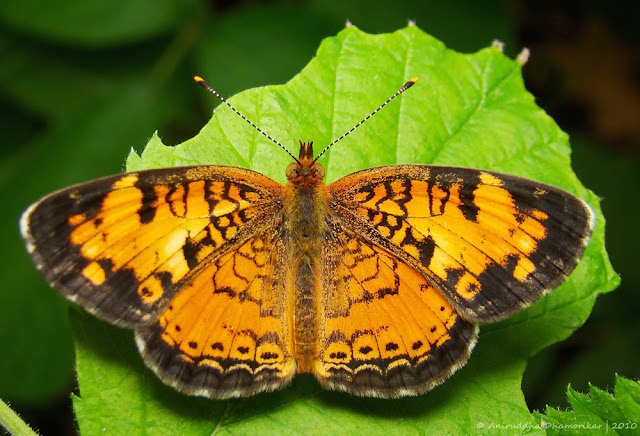 |
| Pearl Crescent butterfly photographed at Turkey Point |
Pearl Crescent was one of the commonest butterflies seen throughout summer. It was commonly seen along grassy patches near Long Point and around rocky shores dominated by shrubs on Manitoulin Island.
12. Little Wood Satyr, Megisto cymela
It is a common butterfly seen basking in forest clearings on low shrubs or are seen fluttering about the dense woodlands of southern Ontario. Many of these were seen in late May and June. I did not come across any Little Wood Satyrs at Manitoulin, which was occupied more commonly by Common Wood Nymph.
13. Common Wood Nymph, Cercyonis pegala nephele
This subspecies is characterized by darker color compared to other subspecies. It was observed in good numbers at Manitoulin Island, frequently seen basking on shrubs as well as tall trees. Although named ‘wood nymph’ it was not seen in woodlands, but rather along forest edge.
14. Common Ringlet, Coenonympha tullia inornata
It is a butterfly commonly seen flying low on the ground near grassy habitats at Long Point. The subspecies C t. inornata is known to occur in most of eastern Canada. According to CBIF, it has been expanding southward for some years into southern Ontario. Based on this, I found this butterfly to be very common in and around Long Point.
Lycaenidae: Commonly referred as ‘Blues’ because the predominant color on the upper wings of these butterflies is blue. These are usually small butterflies, famous for their association with ants. The larvae possess glands that secret sugary substance that attracts ants, thus they bribe ants to protect them from potential predators. Some of the larval stages of the Blues are also known to prey on little insects such as mealy bugs and aphids.
1. Summer Azure, Celastrina neglecta
Only one specimen was observed in the first week of September. This is not surprising since according to CBIF, second- and third-generation are not rare in southern Ontario, considering the fact that the butterfly I saw belonged to this generations. It is a common butterfly in suburban as well as forested areas – preferring weedy fields.
2. Silvery Blue, Glaucopsyche lygdamus
A small lycaenid, there is only one subspecies couperi identified in Canada according to CBIF. It is known to occur all over Canada, except from southwestern Ontario where its southern limit is Ancaster. This is interesting, since I recorded it at Turkey Point, which is far south of Ancaster.
Comment from an expert from CBIF: This species has switched its main larval host plant to Cow Vetch (Viccia cracca) - an introduced legume, and this is allowing it to spread its range farther south into southwestern Ontario and also into the Northeastern United States.
It is interesting to observe good (or bad) effect on the biodiversity because of an introduced species.
3. Eastern tailed Blue, Everes comyntas
This butterfly was seen during early May and early September at Turkey Point. It was however more common during September. According to CBIF, it has two or three generations between May and October.
4. Coral Hairstreak, Satyrium titus
It is the only tailless Hairstreak in Canada. Only one specimen was seen in July at Manitoulin Island.
5. Bronzed Copper, Lycaena hallus
It is a large Copper seen commonly during mid-June to mid-September. Only one specimen was observed at Port Rowan in June.
6. American Copper, Lycaena phlaeas
This butterfly is smaller than Bronze Copper. It was fairly common throughout Turkey Point in September.
7. Dorcas Copper, Lycaena dorcas
| Dorcas Copper showing under wings |
| Dorcas Copper showing upper wings |
Hesperiidae: These butterflies are supposedly a link between moths and butterflies – because of their superficial resemblance to moths. This however is debatable, since these butterflies, commonly referred to as ‘Skippers’ are similar to other butterfly families than moths. They are usually small, drab-looking butterflies known for their fast and rapid flight.
1. European Skipper, Thymelicus lineola
It was introduced in early 1900s probably via imported seeds of Timothy Grass. Only a few butterflies were seen around Long Point, but they surpassed the populations of any other butterfly on Manitoulin Island during July. They however ceased to exist in August, with not a single specimen seen around. This outburst of population is mostly because this is the only North American skipper whose eggs hibernate.
2. Least Skipper, Ancyloxypha numitor
It is a small skipper seen commonly in grassy areas in and around Long Point during June.
3. Hobomok Skipper, Poanes hobomok
This skipper was commonly seen in forest openings and edges at Long Point. It was more common in the month of June than May.
4. Leonard’s Skipper, Hesperia leonardus
There are two subspecies, leonardus occurs in the east and pawnee in eastern prairies. I am not sure which subspecies I recorded, but I’d go with leonardus, since it occurs in southern Ontario. Only one specimen was observed feeding on Goldenrods on the shores of Manitoulin Island.
5. Little Glassywing, Pompeius verna

I’m still unsure of the identification of this butterfly, which could either be P verna or Dun Skipper Euphyes vestris, since both share similar distribution in southern Ontario. It was seen around mid-week of July.
6. Juevnal’s Dusky Wing, Erynnis juvenalis
| Juvenal's Duskywing, male |
7. Silver-spotted Skipper, Epargyreus clarus (no photograph)
This is the largest resident Skipper in Canada (CBIF, 2010). Only two specimens were observed, one in early July and one in early September. I missed the opportunity to photograph this butterfly on both occasions! They were observed basking on the ground, but took to flight as soon as they sensed movement.
Pieridae: The butterflies of this family are commonly referred to as ‘Whites and Yellows’ or ‘Sulphurs’ because the predominant color in this family is white or yellow.
1. Cabbage White, Pieris rapae
Cabbage Whites are ubiquitous in Ontario, especially in disturbed habitats dominated by invasive weeds. It was introduced into North America in Quebec in 1860s (CBIF, 2010). According to CBIF, they become more common as summer progresses, this explains why I saw more number of this species in late August and early September.
2. Clouded Sulphur, Colias philodice
This was another common butterfly seen during August-end and early September. Many specimens were seen feeding on Butterfly Milkweed, and taking shelter in the grass.
Papilionidae: The butterflies of this family are commonly referred to as “Swallowtails” because most of these butterflies display a swallow-tail like extension of the hind-wing. They are usually large, brightly colored butterflies.
1. Eastern Tiger Swallowtail, Papilio glaucus
Many specimens – males and females, were seen during the months of May and early June in and around Long Point. These large swallowtails are seen flying high in the canopy, often visiting the ground to feed on flowers.
For many, butterflies are a mere delight. But what is their stand in this diverse world around – is it to please us with their elegant flight and brilliant colors? Of course not, and we know it. First thing that comes to mind when we think of butterflies is plants. Adult butterflies need nectar to fuel their flight, and by visiting flowers they not only refuel, but carry out nature’s own way of regeneration – by pollination and caterpillars require to feed in order to grow. It is therefore not hard to imagine that a butterfly’s life revolves around plants – from the time the egg is laid to the time the adult has to feed on nectar and lay the eggs again. This brings me to think about butterfly conservation. Conservation of butterflies is as complex as conserving tigers, only difference is that not many butterflies are as endangered as the tiger. To protect a tiger, we have to start from the grass roots. We need to conserve its habitat – formed by communities of plants and trees. Likewise for butterflies, we have to conserve these plant communities. Butterflies, like tigers, also face the danger of poaching, with many being hunt in tropical rainforests to be sold worldwide as precious ornamental items. This illegal trade can easily be brought to a stop if only the consumers began to appreciate the real beauty of butterflies in their natural habitat.
| Monarchs feeding on Butterfly Milkweed |
We can also help butterflies sustain the populations in cities by encouraging communities to transform their lawns into butterfly gardens. All you need to do is plant native flora – and the butterflies will make sure to visit you. Happy DIY Home lists native flora that will help you create your own butterfly garden. This recreational effort is also a step towards conservation – and let it be known, there are no small steps. Every step you take is a big effort.
Please feel free to add the butterflies you observed anywhere in Ontario to this list in comments or make corrections if any of the identifications are wrong.
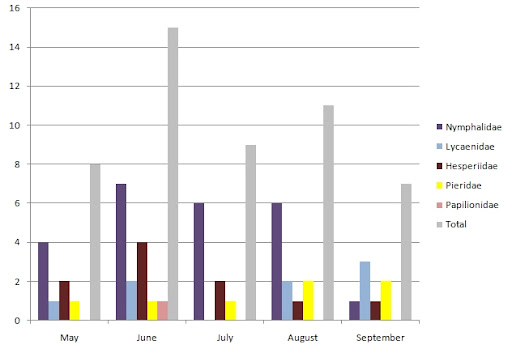
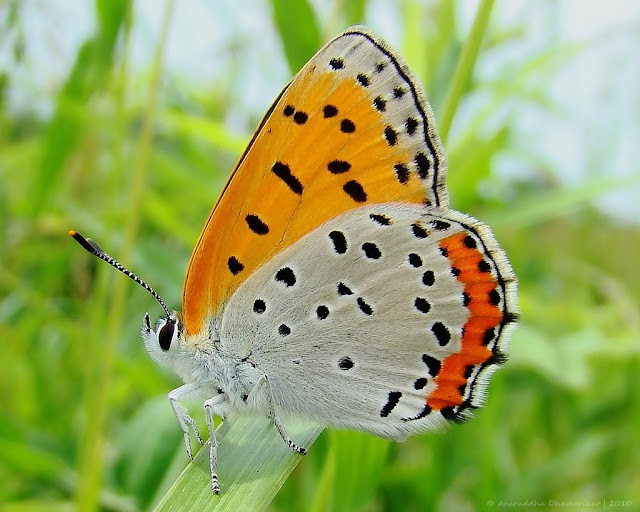
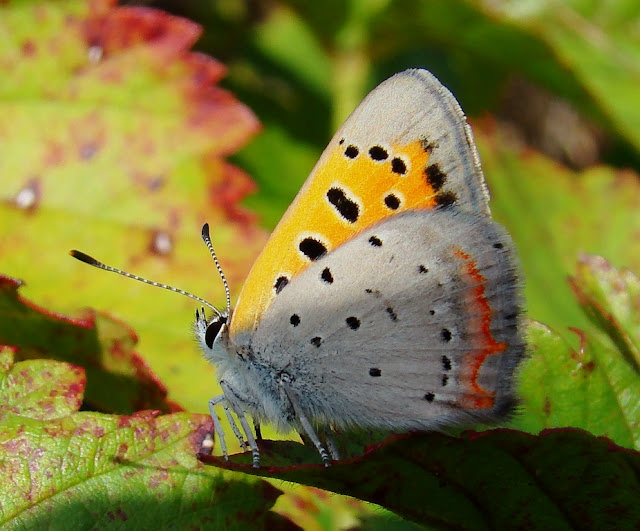

A very interesting and informative article for nature lovers. The pictures are excellent.
ReplyDeleteThese are amazing photos, Aniruddha! Please do us the honour of posting some of these at ButterflyCircle's forums. I am sure our members around the region will be fascinated by these Canadian beauties!
ReplyDeleteAmazing photographs, Anirudhdha! The article is also very interesting and inspiring. I am sure one day I will have a butterfly garden of my own.
ReplyDelete